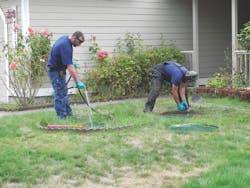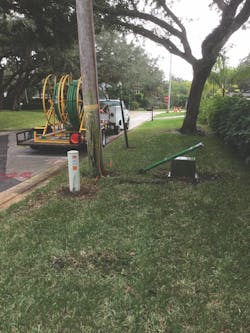Liquid-Only Sewer Briefing
About the author:
Michael Saunders is the market segment leader for engineered systems at Orenco Systems Inc. Saunders can be reached at [email protected].
Liquid-only sewers (also known as “effluent sewers”) have proven to be a cost-effective solution for municipalities, new subdivisions, and a variety of other areas in need of sewer. As opposed to the big pipes and deep excavations typically required by gravity sewers, liquid-only sewers use small-diameter, shallowly buried mainlines that follow the contour of the land and are easily installed with light-duty equipment, minimizing disturbance to the surrounding area.
Because of their affordability, liquid-only sewers have been installed by hundreds of communities over the past several decades. Many of these sewers have now been providing reliable service for more than 35 years.
Effluent Sewer Design Features
In a liquid-only sewer system, the on-site processor provides passive primary treatment. Solids are naturally reduced by anaerobic digestion, with a targeted solids pump-out interval exceeding 10 years. Primary treatment in the processor makes use of lightweight, inexpensive and durable wastewater pumps that typically last more than 25 years. Pump reliability, infrequent solids pump-outs, reduced wastewater strength, and low repair and replacement costs combine for consistent and sustainable long-term maintenance costs.
Primary-treated effluent from the processor is conveyed by the pumps through small-diameter mainlines to the treatment facility. The lower organic and solids load from the liquid-only sewer provides indirect savings in power costs and in solids management costs at the wastewater treatment facility. Also, the reduced organic load of these systems means that designers can decrease the size and associated capital expense of the treatment facility.
The following series of case studies provide examples to illustrate the benefits of liquid-only sewers in real world applications through out the U.S.
Liquid-Only Sewer Sets Standard - Glide, Oregon
In the late 1960s, on-site septic tank and drain field failures were common in the unincorporated community of Glide, Oregon. One after another, three different engineering firms attempted—and failed—to find an affordable solution. In 1973, the county health department enacted a moratorium on any further development in the area.
For the next couple of years, the county’s Department of Public Works studied several options and compared both up-front and long-term costs for a system designed to serve about 2,300 equivalent dwelling units (EDUs). The county researched gravity sewers, vacuum sewers, and pressure sewers, including both grinder and liquid-only sewers.
When the evaluations were done, the department proposed a liquid-only sewer that could eventually serve 7,000 residents. The initial cost of the system would be roughly $10,250 per EDU in today’s dollars. It would be the largest of its kind in North America and would set a standard for innovative design by demonstrating that small communities have more wastewater options than traditional wisdom dictated.
The sewer system in Glide, originally owned by Douglas County, includes more than 20 miles of small-diameter mainline piping over hilly terrain, with no need for lift stations. It currently serves more than 1,100 EDUs, both residential and commercial. Don Kidd is the Glide Idleyld Sanitary District board chairman.
“I was on the advisory board when the county owned Glide’s sewer system,” Kidd said. “In 2006, they wanted to get out from under it and initially planned to sell the system to an outside entity, However, they decided to offer it to Glide’s residents, if we were willing to form a sewer district and operate it.
“They helped us establish the district, then gave us funding to help buy the system,” he continued. “We’ve been able to operate it fairly economically ever since, keeping the rates where we feel they’re reasonable and banking a little money for future needs. It’s been an amazing thing, from inception to installation to operation and it’s allowed Glide to expand.”
Hybrid Collection System - Lacey, Washington
Lacey, Washington, grew rapidly between 1980 and 2000. The town needed an affordable wastewater solution to support construction in the urban growth area it shares with neighboring communities. Lacey chose an Orenco Systems liquid-only sewer, which discharges into the city’s gravity sewer lines, creating a hybrid collection system. More than 25 years later, the system successfully serves approximately 14,000 gravity sewer connections and roughly 4,600 liquid-only sewer connections.
Over the years, its operators have developed experience and expertise in maintaining this hybrid sewer system. Since 2007, service callouts for unplanned maintenance have been stable, averaging 5 to 6% of systems in service, or about four calls per week.
Thomas Faye, senior maintenance technician (Collections) for the city of Lacey, described some of the benefits of this hybrid sewer system.
“Lacey has approximately 70 miles of liquid-only sewer lines and they don’t require lift stations,” Faye said. “With liquid-only sewer, you get to dictate the shortest route to wherever you want it to go. That’s a value-add that people don’t always think about. You can even have it outfall into a manhole. I’ve been working with these systems for 15 years and they’re very simple: economical to maintain, economical to install. They give builders options, and builders can transfer those savings to homeowners.”
Liquid-Only Sewer Helps Clean Lagoon Waters - Vero Beach, Florida
Along the Indian River Lagoon adjacent to Vero Beach, Florida, both residents and government officials were becoming increasingly concerned about excessive nutrient loads and pollution. About 1,500 homes in Vero Beach had septic systems, many of which were antiquated and failing. Experts believed that the failing on-site systems were a major contributor to the environmental degradation of the lagoon, loss of sea grass habitat, and the unexplained deaths of manatees and dolphins.
The city of Vero Beach installed an liquid-only sewer consisting of directionally drilled, small-diameter mainlines and individual Septic Tank Effluent Pump (STEP) packages. Primary-treated effluent from each residential or multi-family property is ultimately conveyed to the city’s existing centralized wastewater treatment plant.
At full build-out, with an estimated 1,500 residences connected to the city’s liquid-only sewer, water quality in the Indian River Lagoon is expected to improve considerably. In its news release, the water management district reported that “the STEP project will divert septic system effluent … preventing up to 40,500 pounds [18,370 kg] of nutrients per year from entering the groundwater.”
Replacement of failed septic systems will result in fewer pollutants ending up in the lagoon. Local officials are confident this will be a boon to the dolphins, manatees, and other wild creatures that make their home in these vital waters. The first on-lot systems were installed in April 2015. Nearly five years later, Robert Bolton, Vero Beach’s director of Water and Sewer, described the system’s operation as “excellent, with no issues.”
Liquid-Only Sewer Versus Gravity Sewer - Montesano, Washington
Installed in 1991, Montesano’s liquid-only sewer system has nearly 1,600 connections in Washington. It replaced an antiquated gravity sewer that suffered extreme infiltration and inflow. Initially, the city’s engineer proposed a new gravity sewer system. However, due to tight lot constraints, the 1.5-year expected installation time, and the physical disruption a gravity sewer installation would cause, the city council and public works department requested that other options be presented.
Montesano’s liquid-only sewer system was installed in half the time and at a lower cost than the proposed gravity sewer. Additionally, it allowed the town to convert the existing gravity sewer to a storm sewer and reduced the size of the wastewater treatment plant.
“It’s a great system for the environment and our treatment plant,” said Norm Case, a Level III utility maintenance employee at Montesano. “We have one full-time employee and two part-time ‘floater’ employees. If we had a gravity sewer system here, we’d have to have more employees because you always have blockages, you’re going into manholes and cleaning things out, etc. Also, we can do everything from above the system and we don’t need a vac truck or big septic truck, either. That’s another great bonus.”
Low Maintenance for Liquid-Only Systems - Southwest Barry County, Michigan
To preserve and improve water quality, this Michigan lake county has had a liquid-only sewer system since 1993. The collection system began with more than 1,200 on-lot STEP units, which have been so dependable that almost a thousand more have since been installed.
The county also maintains about 250 homes with grinder sewer systems. Scott Monroe started as the superintendent of the county’s sewer and water authority in 1993 and is now the general manager.
“I’ve analyzed historical data and we easily get three times the repair callouts for grinder systems as we do for our effluent sewer systems,” he said. “Also, the duration of grinder unit service calls is twice as long as for the STEP units. I haven’t had one employee in 26 years that preferred grinder systems over effluent sewer systems – not one.”
Editor’s Note: Data used by Orenco to derive the representations and conclusions contained within these case studies were current as of January 2020.



